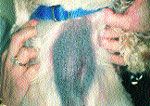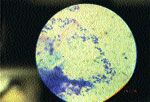Malassezia Dermatitis: Is it Complicating your Life?
Malassezia (yeast) dermatitis can result in a primary skin problem or be present secondary to underlying disease.
Malassezia (yeast) dermatitis can result in a primary skin problem or be present secondary to underlying disease. Because its presence can mimic (and complicate) other diseases such as atopy and food allergy, it is important to know how to recognize the organism, and of course, treat for it.

Shih Tzu with erythema, seborrhea oleosa, pruritus and odor due to Malassezia affecting the ventral neck and leg folds.
Malassezia pachydermatis (Pityrosporum) is a lipid-loving, normal inhabitant of canine and feline skin residing in the ear canals, rectum/anal sacs and vagina. It was first described as a disease in humans (seborrheic dermatitis) in 1847 by Malassez. The commensal yeast organism becomes a problem due to excessive sebum production (Malassezia loves lipids), heat, humidity, bacteria or inflammation. Underlying allergy or endocrine disease i.e. hypothyroidism can predispose to yeast infection. Enhanced yeast growth can occur when Staphylococcus spp. are present. New studies indicate that yeast is present in greater amounts in atopics with a yeast hypersensitivity state possible. Inflammation may occur because of lipases released by the yeast that liberate zymogen thereby activating complement.
No discrimination
Malassezia dermatitis can affect any age, breed, or gender of dog but some breeds appear to be predisposed including the Shih Tzu, Lhasa Apso, Cocker Spaniel, Jack Russell Terrier, Poodle, West Highland White Terrier, Shetland Sheepdog, Labrador Retriever, Chihuahua, Maltese, Basset Hound, German Shepherd, Dachshund, Springer Spaniel and Golden Retriever. Clinical findings include pruritus, odor, seborrhea oleosa, yellow or gray scaling, erythema and lichenification.
Areas of the body affected include skin folds such as the ventral neck, axillae, groin, umbilical fold, nailbeds, perineum, muzzle and ears. Some canine patients experience intense facial/muzzle pruritus almost to the point of the owners believing the patient is having a seizure. Other canine patients with a generalized yeast dermatitis seem depressed, with improvement in activity/attitude after treatment.
Malassezia dermatitis/otitis does not appear to be as common in cats, but generalized cases have been reported. Yeast has been recognized in feline acne and also associated with a black, waxy otitis externa. Recurrent generalized Malassezia in cats has been associated with FIV infection.

Ventral neck fold in a Cocker Spaniel with Malassezia skin fold pyoderma.
Some reports indicate that 50 percent of the time, Malassezia dermatitis in dogs can be associated with underlying allergy. Hypersensitivity reactions to Malassezia have been documented in humans and there is reason to believe that this may be true in dogs as well.
Diagnosis
The quickest and easiest way to diagnose Malassezia is by cytology.
Impression smears are made using a microscope slide pressed against the skin, or a surgical blade or a swab of the skin using a cotton-tipped swab. The slide is heat fixed then stained with Diff-Quik, Gram Stain, or Methylene Blue and observed under oil immersion. Malassezia appears as round or oval budding yeast-like cells 3-8um in diameter staining dark blue. They are either single, clumped, or adhered to keratinocytes. Normal numbers of yeast vary between 3-6/hpf. Cultures are usually not necessary but if desired, Sabouraud's dextrose agar is used. It may be helpful to add oil to the culture medium as yeast are lipid-loving and oil will encourage their growth. Histopathology occasionally reveals yeast in the upper layers of the epidermis but they can easily be washed off in the sample preparation process. When yeast are observed in hair follicles, be suspicious of possible pathogenicity. In some cases, the diagnosis of Malassezia dermatitis depends upon the response to therapy.

Close up photo of the Cocker Spaniel.
Treatment
Systemic therapy for Malassezia dermatitis involves antifungals such as ketoconazole, itraconazole, or fluconazole. Griseofulvin has no activity against Malassezia. Ketoconazole (Nizoral) 2.5-5mg/kg bid orally for two to four weeks is the usual drug of choice.
Some patients may need a low maintenance dose to keep them under control. Potential side effects include anorexia, vomiting, diarrhea, and lethargy. Ketoconazole can lower cortisol levels in some patients and the addition of prednisone 0.l mg/lb sid may be necessary.
Antifungals can also be teratogenic and lower testosterone levels. Ketoconazole can elevate liver enzymes in humans so it is advisable to monitor serum profiles in canine and feline patients on ketoconazole (and the other azoles) longer than two months. Itraconazole (Sporanox) is dosed at 5mg/kg/day orally. It is more expensive than ketoconazole yet does not tend to cause as many gastrointestinal side effects. It may cause less vomiting in cats compared to ketoconazole, however some cats have developed hepatotoxicity. Fluconazole (Diflucan) has been used in dogs at 2.5-5mg/kg/day orally.
It may be advisable in some patients to treat initially with antibacterials combined with antiyeast medication as most often Staph bacterial infections accompany Malassezia dermatitis.

Numerous dark blue staining yeast organisms viewed under the microscope.
Topical therapies include shampoos such as Nizoral shampoo, Sebahex, Malaseb, Miconazole, Dermazole, benzoyl peroxides, chlorhexidine-at least 2 percent, selenium sulfide, tar (not in cats), iodine or lime sulfur. Shampoos followed by a leave-on rinse with antiyeast activity such as Resichlor or a 50:50 vinegar/water mixture may provide a more lasting effect.
Underlying culprit
Remember to check for underlying disease as the cause of the Malassezia problem. Atopy, food allergy, endocrine disorders, demodicosis, and bacterial pyoderma can be accompanied by Malassezia. Finally, there have been two reports of Malassezia being "contagious" to other animals and humans.
One case occurred in a colony of laboratory Beagles, the other in a pediatric intensive care unit transferred by a nurse petting her dog and not washing her hands before handling patients.